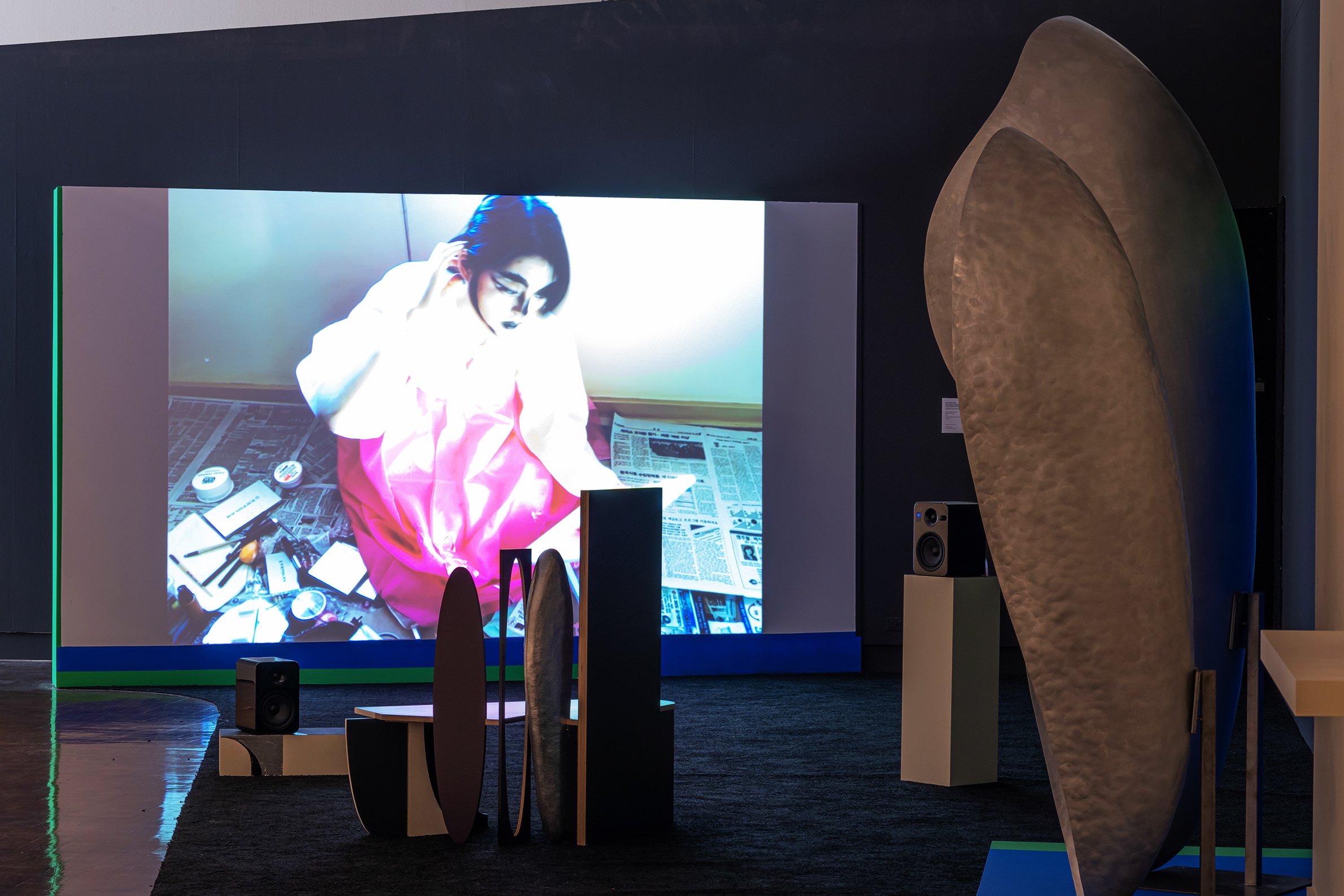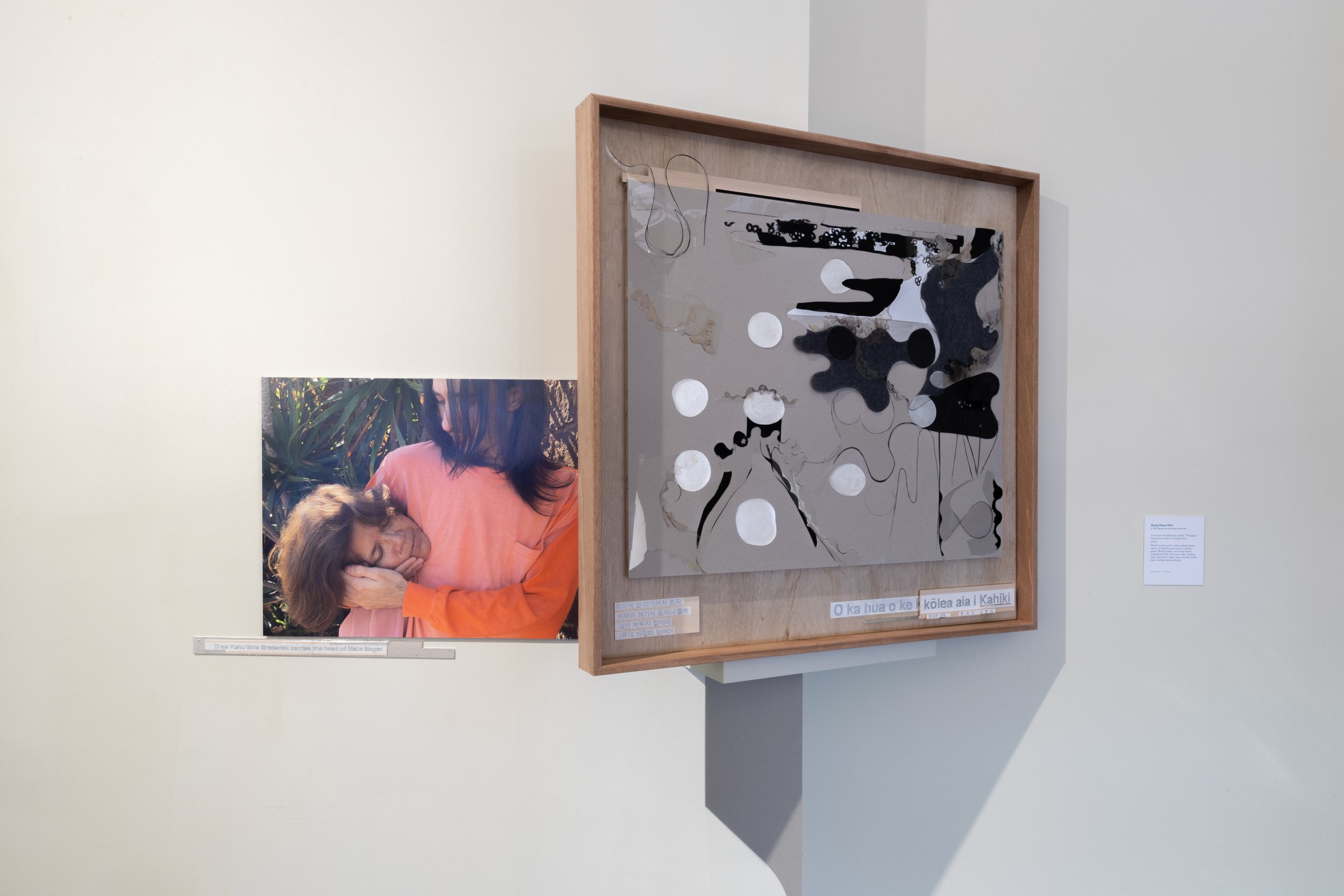hawai‘i triennial 2022
@ HONOLULU MUSEUM OF ART
Sung Hwan Kim
in musical collaboration with David Michael DiGregorio
b. 1975, Seoul
lives and works in New York
b. 1979, Boston
lives and works in New York
[CLOCKWISE, FROM TOP LEFT] Sung Hwan Kim (in musical collaboration with David Michael DiGregorio), Hair is a piece of head 머리는 머리의 부분, 2021, video (color, stereo sound), 23 mins; Sung Hwan Kim, O ka hua o ke kōlea aia i Kahiki The egg of the plover is laid in a foreign land, 2022, pencil, acrylic paint, water-based poster paint, oil-based poster paint, tracing paper, Bristol paper, mounting board, transparent film, aluminum tape, hinging tape, document repair tape, double-sided tape, acetate tape, and glue; tip of a spherical form (ear), 2021, aluminum and steel; tip of a spherical form (cupped fingers), 2021, aluminum and steel; second seat for one person, 2021/2022, painted plywood, silver leaf, aluminum; Honolulu Museum of Art, HT22. Courtesy of the artists and Honolulu Museum of Art.
Sung Hwan Kim works in film, video, drawing, painting, architecture, literature, installation, performance, radio broadcast, and print publication. Adopting different roles—director, editor, writer, composer, performer, narrator, educator, researcher—Kim collaboratively explores marginal stories of peoples and places through his physical and psychological experiences.
For HT22 Kim and frequent collaborator composer David Michael DiGregorio present a new installation, Hair is a piece of head 머리는 머리의 부분 (2021). The installation includes a multilingual video of the same title, spoken in Mandarin, Korean, Hawaiian, and English, and is a portion of the larger multi-part research project A Record of Drifting Across the Sea (2017–), focused on undocumented Korean immigrant histories in the U.S. at the turn of the twentieth century.
Hair is a piece of head features Suin Kwon, Yoon Jin Kim, Byungjun Kwon, local friends Geoffrey Farmer, Auliʻi Mitchell, Ahukiniakealohanui Fuertes, and members of the Meyer and Broderick families. Commenting on familial bonds and facial resemblance with respect to the video, Kim states, ‘I imagine the relation between head and hair as that between a mother and child, in the context of he pilinia wehena ʻole [unseverable association]. But I also wonder about what this deep bond looks like to someone who is outside of the connection.’
Hair is a piece of head makes use of the iPhone camera feature ‘Live Photos’ to quote documentation of ‘picture’ brides who, at the turn of the twentieth century, journeyed to Hawaiʻi through a matchmaking process dependent on exchanging and selecting photographs. In the video, Hawaiʻi is both an idea and a reality—an interstitial realm that has served for centuries as a point of passage for most, if not all, immigrants crossing the Pacific. Ironically, many oral-history accounts of migration, even those that are lesser known, are often oblivious to the dwindling fate of another nation—in this case, that of Kānaka ʻŌiwi, Native Hawaiians. This harsh reality is also an integral part of the work and is reinforced through a sound ‘haiku’ composed by DiGregorio that quotes a guitar strummed by George Helm, a beloved Hawaiian musician and activist.
Kim identifies three significant pieces of imagery which provided motifs for the video:
1. Choi Ik-Hyun, a traditionalist from the terminal Korean dynasty, who, in 1896, said, ‘I would rather have my head cut off than cut my hair’, a statement against the republican revolution that ultimately forced all male adults to modernize their hairstyle. The quote has been co-opted by both right- and left-wing groups since then (pride; tradition; education; glory).
2. A photograph taken by Ed Greevy of an activist, Terrilee Kekoʻolani, her hair blown by the wind around microphones in the Save Our Surf demonstration at Wāwāmalu, Oʻahu, in 1972 (justice; reason; tradition).
3. A song taught in an American school in California circa 1910, as documented by Mary Paik Lee (education; pride):
‘Ching Chong Chinaman
Sitting on a wall
Along came a white man
And chopped his head off’
Originally commissioned by Gwangju Biennale Foundation, Kim and DiGregorio collaboratively produced the video in Oʻahu and Kauaʻi across 2019 and 2020, with additional support from TRADES Artist in Residence, Puʻuhonua Society, and Koa Gallery, Kapiʻolani Community College. The installation for HT22 includes a new formation of drawings created in Wilhelmina Rise, Honolulu, and other elements previously fabricated for exhibition at Kravis Studio, Museum of Modern Art, New York.
Sung Hwan Kim. Courtesy of the artist.
Sung Hwan Kim uses film and video, drawing, architecture, and historical and marginal literature as well as his own writing, which often become a part of installation, performance, radio play, or book. Using cinematic language, Kim's work incorporates intimate views of the spatial patterns in architecture and psychological traces of the relationship in it. Kim has most recently exhibited his work at Asia Art Center, Gwangju, Korea (2021); National Museum of Modern and Contemporary Art, Gwacheon, Korea (2019); the 57th Venice Biennale Arte (2017); and Berwick Film and Media Arts Festival, Berwick, UK (2017).
His works have been shown in international biennales and film festivals, such as the Gwangju Biennale, Performa, Manifesta, Berlin Biennale, Rotterdam International Film Festival, and Rencontres Internationales Paris/Berlin. He was a fellow at the Rijksakademie van Beeldende Kunsten (2004/2005) and a recipient of Berliner Künstlerprogramm des DAAD (2015). His publications include Talk or Sing (distributed by ArtSonje); Ki-da Rilke (distributed by Sternberg Press); and When Things Are Done Again (distributed by Tranzitdisplay).
David Michael DiGregorio, born in 1979, is a composer and musician based in New York, who writes music for film and video, solo concert, and performance works in chamber-style settings and for the larger stage. His background includes extensive work on classical and improvised technique on the piano, work with various vocal techniques, performance with a gospel choir, electro-acoustic composition, and experimental pop construction.
He has collaborated since 2006 with Sung Hwan Kim, initially through development of the in the room series. Highlighted work in musical collaboration with Kim: music for the Venice-Biennale-commissioned film Love before Bond, 2017; composition and performance in the operatic experiment 피나는 노력으로 한 [A Woman Whose Head Came Out Before Her Name] (2015), commissioned for the Asian-Arts-Theatre inaugural festival, Gwangju; music for the Tate-Modern-commissioned 2012 film Temper Clay. This collaboration has also manifested in the recording of various music albums including one from in the room (2010) (Bayerischer-Rundfunk-2 broadcast commission and Intermedium Records); and In Korean Wilds and Villages, 2009, produced by Andi Toma (Sonig Records).
DiGregorio also has collaborated with artist Jewyo Rhii, choreographer Martín Lanz Landázuri, musician Byungjun Kwon, singer Elizabeth Jane Dudley Baker, and has arranged original music for Ari Benjamin Meyers’ Kunsthalle for Music Ensemble (Witte de With, Rotterdam, 2018); and has performed solo concerts at Pirelli HangarBicocca, Milan; Ilmin Museum, Seoul; New Museum, New York; Insa Art Space, Seoul; De Nieuwe Kraakgeluiden and STEIM, Amsterdam.
http://dogr.org; ig: @dogr_music





